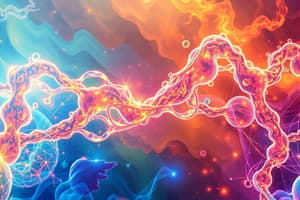Podcast
Questions and Answers
What is the definition of energy in a thermodynamics context?
What is the definition of energy in a thermodynamics context?
- The sum of potential and kinetic energies only
- The capacity to supply heat or do work (correct)
- The energy stored in chemical bonds exclusively
- The ability to create matter
Which statement best describes kinetic energy?
Which statement best describes kinetic energy?
- Energy of an object at rest
- Energy stored due to height
- Energy of motion dependent on mass and velocity (correct)
- Energy that cannot be converted to work
What does the first law of thermodynamics state?
What does the first law of thermodynamics state?
- Energy can be created or destroyed
- Energy cannot be converted into another form
- All forms of energy are equally convertible
- The total energy of an isolated system is constant (correct)
Which unit is used to express thermal energy?
Which unit is used to express thermal energy?
How is heat defined in thermodynamics?
How is heat defined in thermodynamics?
What type of energy is stored in chemical bonds?
What type of energy is stored in chemical bonds?
Which form of energy is NOT considered within the definition of energy?
Which form of energy is NOT considered within the definition of energy?
What can the conservation of energy principle imply for energy transformations?
What can the conservation of energy principle imply for energy transformations?
What is the correct formula to calculate the standard enthalpy change for a chemical reaction?
What is the correct formula to calculate the standard enthalpy change for a chemical reaction?
What is the standard heat of formation (DfH0) of O2(g)?
What is the standard heat of formation (DfH0) of O2(g)?
In the reaction CO(g) + ½O2(g) → CO2(g), what is the standard enthalpy change (DrxnH0) calculated to be?
In the reaction CO(g) + ½O2(g) → CO2(g), what is the standard enthalpy change (DrxnH0) calculated to be?
How do you determine the enthalpy change when DfH values are not available?
How do you determine the enthalpy change when DfH values are not available?
What is the sign of bond dissociation energies?
What is the sign of bond dissociation energies?
Which is the correct approximation formula for calculating enthalpy change using bond dissociation energies?
Which is the correct approximation formula for calculating enthalpy change using bond dissociation energies?
What does Hess' Law enable in the context of enthalpy changes?
What does Hess' Law enable in the context of enthalpy changes?
Why should coefficients of substances in a balanced equation be considered in enthalpy calculations?
Why should coefficients of substances in a balanced equation be considered in enthalpy calculations?
What happens to the internal energy of a system when work is done by the system against the external pressure?
What happens to the internal energy of a system when work is done by the system against the external pressure?
How is the work done by the system mathematically expressed in relation to pressure and volume change?
How is the work done by the system mathematically expressed in relation to pressure and volume change?
What does Δn represent in the context of the ideal gas equation?
What does Δn represent in the context of the ideal gas equation?
In the reaction 3H2(g) + N2(g) → 2NH3(g), what is the work done when the volume decreases?
In the reaction 3H2(g) + N2(g) → 2NH3(g), what is the work done when the volume decreases?
Which of the following scenarios would result in no work being done?
Which of the following scenarios would result in no work being done?
According to Avogadro’s law, what happens to the volume of gas when the number of moles increases?
According to Avogadro’s law, what happens to the volume of gas when the number of moles increases?
What expression signifies the change in internal energy (ΔU) of a system?
What expression signifies the change in internal energy (ΔU) of a system?
In a chemical reaction where the moles of gaseous products are greater than those of the gaseous reactants, what effect does this have on the work?
In a chemical reaction where the moles of gaseous products are greater than those of the gaseous reactants, what effect does this have on the work?
What is the nature of the lattice energy (U) for an ionic solid?
What is the nature of the lattice energy (U) for an ionic solid?
According to Coulomb's law, what factor increases the force of attraction between ions?
According to Coulomb's law, what factor increases the force of attraction between ions?
What happens to the lattice energy as the cation size decreases when anion size is constant?
What happens to the lattice energy as the cation size decreases when anion size is constant?
In the Born-Haber cycle, which step is typically exothermic?
In the Born-Haber cycle, which step is typically exothermic?
What is the final energy result (DrxnH) when Na+(g) and Cl-(g) combine to form NaCl(s)?
What is the final energy result (DrxnH) when Na+(g) and Cl-(g) combine to form NaCl(s)?
How is the total energy of the reaction calculated when forming NaCl(s)?
How is the total energy of the reaction calculated when forming NaCl(s)?
What is required for the stability of a crystal lattice?
What is required for the stability of a crystal lattice?
Which statement correctly describes the energy involved in the atomization of chlorine?
Which statement correctly describes the energy involved in the atomization of chlorine?
What characterizes an open thermodynamic system?
What characterizes an open thermodynamic system?
How is total internal energy (U) defined?
How is total internal energy (U) defined?
What does a negative change in internal energy (ΔE) indicate?
What does a negative change in internal energy (ΔE) indicate?
Which of the following is true regarding state functions?
Which of the following is true regarding state functions?
What occurs during a reversible process concerning state functions?
What occurs during a reversible process concerning state functions?
Which system is defined as one with no exchange of energy or matter with its surroundings?
Which system is defined as one with no exchange of energy or matter with its surroundings?
What formula represents the concept of physical work in thermodynamics?
What formula represents the concept of physical work in thermodynamics?
What condition does NOT affect the internal energy of a system?
What condition does NOT affect the internal energy of a system?
What is the total bond dissociation energy required to break the bonds for the reaction H2(g) + Cl2(g) → 2HCl(g)?
What is the total bond dissociation energy required to break the bonds for the reaction H2(g) + Cl2(g) → 2HCl(g)?
In the enthalpy change calculation for the reaction 2NH3(g) + Cl2(g) → N2H4(g) + 2HCl, which bond dissociation energy is positive?
In the enthalpy change calculation for the reaction 2NH3(g) + Cl2(g) → N2H4(g) + 2HCl, which bond dissociation energy is positive?
Which formula correctly represents the calculation for DrxnH0 using bond dissociation energy?
Which formula correctly represents the calculation for DrxnH0 using bond dissociation energy?
What is the correct enthalpy change (DrxnH0) for the reaction CH4 + 3Cl2 → CHCl3 + 3HCl?
What is the correct enthalpy change (DrxnH0) for the reaction CH4 + 3Cl2 → CHCl3 + 3HCl?
For the bonds formed in the reaction CH4 + 3Cl2 → CHCl3 + 3HCl, which bond is formed the most times?
For the bonds formed in the reaction CH4 + 3Cl2 → CHCl3 + 3HCl, which bond is formed the most times?
What does Coulomb's law describe regarding ionic interactions?
What does Coulomb's law describe regarding ionic interactions?
What is the bond dissociation energy of H-Cl as given in the content?
What is the bond dissociation energy of H-Cl as given in the content?
Which statement about bond dissociation energy and reactions is true?
Which statement about bond dissociation energy and reactions is true?
Flashcards
Energy
Energy
The capacity to supply heat or do work.
Kinetic Energy
Kinetic Energy
Energy of motion, calculated as 1/2 * mass * velocity^2.
Potential Energy
Potential Energy
Stored energy.
First Law of Thermodynamics
First Law of Thermodynamics
Signup and view all the flashcards
Chemical Energy
Chemical Energy
Signup and view all the flashcards
Thermal Energy
Thermal Energy
Signup and view all the flashcards
Heat
Heat
Signup and view all the flashcards
Energy Conservation
Energy Conservation
Signup and view all the flashcards
Thermodynamic System
Thermodynamic System
Signup and view all the flashcards
Surroundings
Surroundings
Signup and view all the flashcards
Open System
Open System
Signup and view all the flashcards
Closed System
Closed System
Signup and view all the flashcards
Isolated System
Isolated System
Signup and view all the flashcards
Internal Energy (U)
Internal Energy (U)
Signup and view all the flashcards
State Function
State Function
Signup and view all the flashcards
Change in a State Function (DX)
Change in a State Function (DX)
Signup and view all the flashcards
P-V Work
P-V Work
Signup and view all the flashcards
Avogadro's Law
Avogadro's Law
Signup and view all the flashcards
Work done by the system
Work done by the system
Signup and view all the flashcards
Work done on the system
Work done on the system
Signup and view all the flashcards
Δn
Δn
Signup and view all the flashcards
Internal Energy Change (ΔU)
Internal Energy Change (ΔU)
Signup and view all the flashcards
Heat Transfer (q)
Heat Transfer (q)
Signup and view all the flashcards
Relationship between ΔU, q, and w
Relationship between ΔU, q, and w
Signup and view all the flashcards
Standard Enthalpy Change (DrxnH)
Standard Enthalpy Change (DrxnH)
Signup and view all the flashcards
Heat of Formation (DfH)
Heat of Formation (DfH)
Signup and view all the flashcards
How do you calculate DrxnH using DfH?
How do you calculate DrxnH using DfH?
Signup and view all the flashcards
Bond Dissociation Energy (DdissH)
Bond Dissociation Energy (DdissH)
Signup and view all the flashcards
How do you calculate DrxnH using DdissH?
How do you calculate DrxnH using DdissH?
Signup and view all the flashcards
What's the relationship between DfH and DdissH?
What's the relationship between DfH and DdissH?
Signup and view all the flashcards
Why use bond dissociation energies?
Why use bond dissociation energies?
Signup and view all the flashcards
What's the key takeaway for DrxnH calculations?
What's the key takeaway for DrxnH calculations?
Signup and view all the flashcards
Bond Dissociation Energy
Bond Dissociation Energy
Signup and view all the flashcards
Enthalpy of Reaction (DrxnH0)
Enthalpy of Reaction (DrxnH0)
Signup and view all the flashcards
How to Calculate DrxnH0
How to Calculate DrxnH0
Signup and view all the flashcards
Coulomb's Law
Coulomb's Law
Signup and view all the flashcards
Lattice Energy
Lattice Energy
Signup and view all the flashcards
Factors Affecting Lattice Energy
Factors Affecting Lattice Energy
Signup and view all the flashcards
Exothermic vs. Endothermic
Exothermic vs. Endothermic
Signup and view all the flashcards
Bond Strength and Enthalpy Change
Bond Strength and Enthalpy Change
Signup and view all the flashcards
Lattice Energy (U)
Lattice Energy (U)
Signup and view all the flashcards
Born-Haber Cycle
Born-Haber Cycle
Signup and view all the flashcards
Why is Lattice Energy Positive?
Why is Lattice Energy Positive?
Signup and view all the flashcards
Lattice Energy and Ionic Radius
Lattice Energy and Ionic Radius
Signup and view all the flashcards
Lattice Energy and Charge Magnitude
Lattice Energy and Charge Magnitude
Signup and view all the flashcards
How does Lattice Energy Affect Stability?
How does Lattice Energy Affect Stability?
Signup and view all the flashcards
Study Notes
Thermodynamics
- Thermodynamics is the study of energy and its transformations.
- Chemical reactions either require or release energy.
- Reactions occur due to a change in relative stability of reactants and products. Lower energy signifies higher stability.
- Higher energy (less stable) indicates greater reactivity.
Energy
- Energy is the capacity to do work or supply heat.
- It can be kinetic (energy of motion) or potential (stored energy).
- Kinetic energy (Ek) is calculated as 1/2 * mass * velocity².
- Potential energy (Ep) is stored due to position or chemical bonds.
Energy Changes & The Laws of Thermodynamics
- Energy is conserved; it cannot be created or destroyed, only transformed.
- Thermal energy (heat) is the kinetic energy of molecular motion. Measured by temperature.
- Heat is the transfer of thermal energy due to temperature differences.
- Chemical energy is the potential energy stored in chemical bonds.
Important Concepts and Terms
- A thermodynamic system is the specific part of the universe being studied.
- Surroundings are everything outside the system.
- Boundary separates the system from the surroundings.
- Isolated systems neither exchange energy nor matter with surroundings.
- Closed system exchange energy but not matter.
- Open system exchanges both energy and matter.
Internal Energy and P-V Work
- Internal energy (U) is the total kinetic and potential energy of molecules/ions in a system.
- Change in internal energy (ΔU) = final internal energy - initial internal energy.
- ΔU = q + w (where q = heat and w = work).
- P-V work occurs due to volume changes within a system.
- W = −PextΔV (where Pext is external pressure).
Internal Energy and P-V Work Continued
- Energy loss (ΔU is negative) if energy leaves the system.
- Energy gain (ΔU is positive) if energy enters the system.
- State functions are independent of the path taken.
- Internal energy is a state function (it only depends on the initial and final states of the system).
Internal Energy and P-V Work Continued 2
- Change in a state function (e.g., ΔX) for a process is -ΔX for the reverse process.
- Overall change in a state function is zero when returning to the initial state.
- Physical work (W) = force x displacement (W = F x d).
- In chemical systems, P-V work is common; it's related to volume changes.
- Examples include chemical reactions producing gases (e.g., combustion of C₃H₈ + 5O₂ → 4H₂O + 3CO₂).
Internal Energy and P-V Work Continued 3
- In a chemical reaction, work can be calculated as W = -PextΔV
- If there is no change in volume (ΔV=0), no P-V work is done.
Internal Energy and P-V Work Continued 4
- At constant volume, q = ΔU and no P-V work is done.
- At constant pressure, q = ΔH (enthalpy).
- ΔH = ΔU + PΔV
- Enthalpy (H) is a state function related to heat changes.
- H = U + PV
Enthalpy
- Enthalpy (ΔH) is a thermodynamic quantity representing the enthalpy change for a reaction at constant pressure. Important in reacting systems.
- ΔH = ΣΔHproducts - ΣΔHreactants
- Enthalpy change (ΔH) is a state function. Independent of pathway.
- Endothermic process: ΔH is positive (system absorbs heat). Examples: ice melting.
- Exothermic process: ΔH is negative (system releases heat). Examples: combustion of fuels.
Hess' Law
- Hess' law states that the overall enthalpy change for a reaction is independent of the pathway, and it equals the sum of enthalpy changes for individual steps involved in the process.
- Useful for calculating enthalpy values for complicated reactions from known individual enthalpy changes.
Calculating Enthalpy Changes from Heats of Formation
- Heats of formation (ΔfHo) are the enthalpy changes when one mole of a substance is formed from its elements in their standard states. The standard state is 298K and 1 atm pressure).
- We can calculate ΔHorxn (standard enthalpy changes for a given reaction) by considering the heats of formation of the reactants and products, along with the stoichiometric amounts.
- ΔHorxn = Σ n ΔfHo(products) – Σ n ΔfHo(reactants) [n are stoichiometric coefficients]
Calculating Enthalpy Changes from Bond Dissociation Energies
- Bond dissociation energies (BDE) are the enthalpy changes required to break a particular bond in one mole of gaseous molecules.
- To calculate enthalpy changes of a reaction using Average Bond Dissociation Energies, consider the sum of the energies required to break bonds (reactants) and the product bonds. Adiss H ≈Σ bonds broken – Σ bonds formed
Coulombs Forces and Lattice Energies
- Opposite charges attract. The strength of attraction depends on the magnitudes of the charges and the distance between them.
- Lattice energy (U) is the energy needed to separate one mole of a crystalline ionic solid into its gaseous ions. It results from the electrostatic attraction between ions. Important in ionic compounds).
- Larger charges and smaller distances between ions lead to larger lattice energies. For compounds with the same anion, compounds with smaller cations will have larger lattice energies because the smaller cations are closer to the anion and have a larger force of attraction.
Born-Haber Cycle
- Hess's Law can be used to find Lattice Energy. A cycle used to evaluate multiple steps together to get the overall enthalpy of a reaction.
Studying That Suits You
Use AI to generate personalized quizzes and flashcards to suit your learning preferences.




